Home
Africa, Kemet and Sumer
Lands of the Black (Headed) People
"After Anu, Enlil, Enki, and Ninhursag had fashioned the Black-Headed (people), vegetation luxuriated from the earth, animals, four-legged (creatures) of the plain, were brought artfully into existence..."
One of Africa's many civilizations is that of Sumer. Founded along the Tigris and Euphrates Rivers, in Asia-Minor, it in many respects was a twin city of Kemet; spawned by the same progenitors Nubia-Kush, it mirrored Kemet in numerous areas. In the names of cities and towns there was Anu, Mari, Amon, Kush (Kish), Assur (Ausar), and others. Like Pharaohs of Nubia and Kemet, Sumer was as also governed by divine leaders called 'En', who also were considered 'Son of the Sun' or, the 'Son of Anu'. The Ntcheru of Sumer were called Dingir, and they too paralleled those of Nubia-Kemet: For example
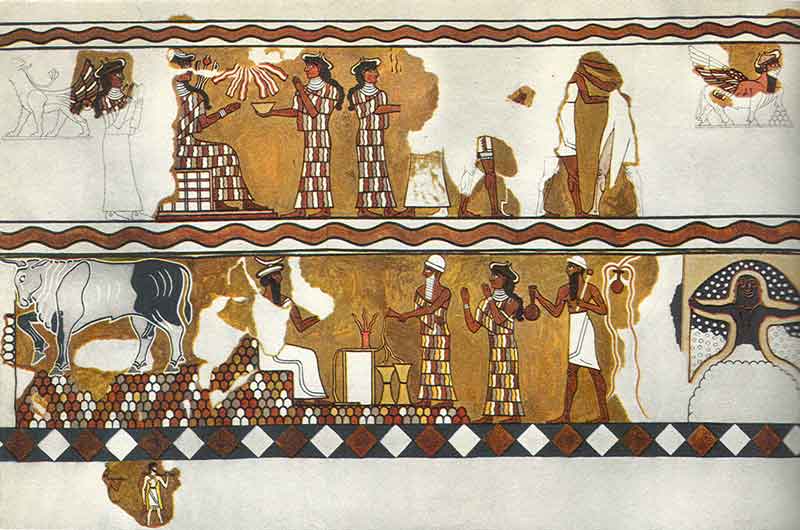
|
| Painting scene from Mari (North-West Sumer) of the Annunaki including Inanna or Nanana (top register) and Enlil (middle register) being attended to by 'lesser-dinger' - the Iggigi. Note the 'African' race of Sumerians as distinct from, and indicated by the Aryan (White) 'fisher-man' and the African 'fisher-man' (partially shown) in the bottom register |
| Comparison of Ntcheru (Kemet) and Dingir (Sumer) | ||
|---|---|---|
| Kemet - Ntcheru | Sumer - Dingir | Manifestation |
| Anu | Anu | Creator |
| Ra | Anu, Utu | Sun |
| Geb | Enlil | Sky, Earth |
| Ausar | Enki, Assur, Asari | Ruler of Earth, Vegetation, Animal, and Man; Ruler of the 'Lower Ennead' (Ausar) / 'Lower Annunaki' [the Iggigi] (Enki), and 'Governor' of moral-behavior on Earth. |
| Auset | Inana, Nanana | Ruler of Earth, Vegetation, Animal and Man; Goddess of fertility and nurturing; Guardian of birth-rite to the throne |
| Ennead | Annunaki | Governing body of Ntcheru / Dingir that reside in Heaven |
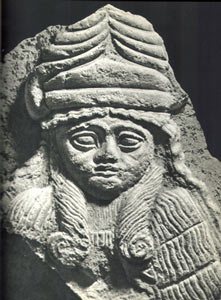 |
 |
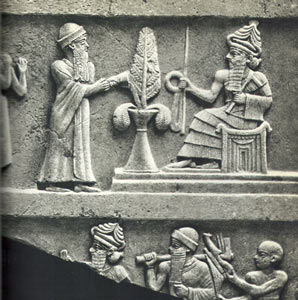 |
| Dingir (Goddess) Inana or Dingir Nanana | Dingir's Ningizzida and another leading Gudea before Enki or Anu | En Ur-Nammu pours libation before Dingir Nannar. (below) Dingir Nannar leads En Ur-Nammu en-route to temple building |
Kemet and Sumer built great solar temples to the Ntcheru / Dinger. Kemet built Pyramids whereas Sumer built Ziggurats; additionally both built temples to honor the other types of Ntcheru / Dingir - i.e. Creators, Elements and Principals.
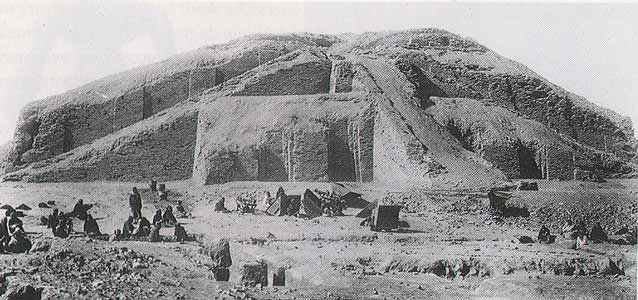 |
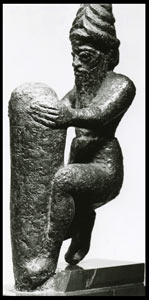 |
| The Ziggurat of Ur, one of the 'sun-temples' built to honor Great Dingir Anu and Innana, influenced and guided by the Kemetic philosophy associated with the Kemetic 'Step-Pyramid' [sun-temple] of Ghiza, and the even earlier pyramids [sun-temples] of Nubia-Kush | Dingir Enki [Ruler of Earth, establisher of government, governor of order] driving a (building) foundation stake into the ground |
Both societies are families related by Ancestors - the Anu. In Sumer everyone is related to Anu - the creator - and Anu (the first people); likewise, in Kemet everyone is related to Anu - the creator - and to Anu (the first people). Lastly, both, in response to Aryan (White) invaders distinguished themselves as black people - i.e. Kemet = Land of the Black People and Sumer, Sa-Ga-(Gi) = The Black Heads / The Black Headed People.
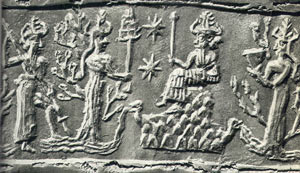 |
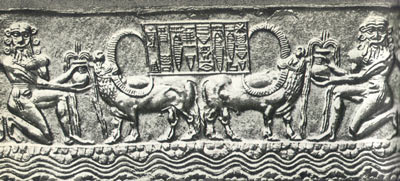 |
| Great Dingir Anu presented to by other Dingir of 'High Heaven' | Mythological characters believed to be the hero Gilgamesh (and Enkimdu?) feeds water to a pair of bulls |
Each society revered creation and the governing 'life forces', and both generated outstanding periods in their history along with distinguished leaders. Of the Third-Dynasty in Kemet the Pharaoh distinguished himself and the society by commissioning the building of the first major pyramid - the Step Pyramid; in association with him the Great and Grand Vizer Imhotep distinguished himself as the architect of the Step Pyramid and as a multi-genius, in addition to being an outstanding Seba (spiritual leader). Right on the heels of Kemet, Sumer was distinguished by the Great En Naram-Sin who commissioned the building the Great Ziggurat for the Dingir Anu and Inanna (Inana); in association with him the Great Spiritual Leader Gudea distinguished himself and the Sumerian society by leading the revival and progression of Sumerian religion and spirituality. The era of Naram-Sin and Gudea is known as Ur III.
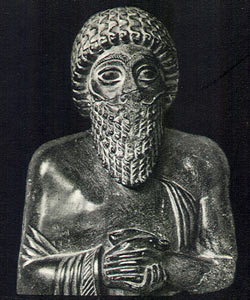 |
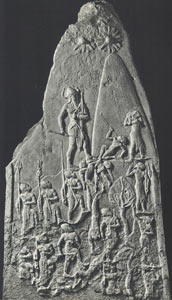 |
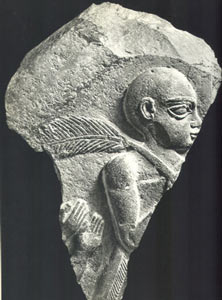 |
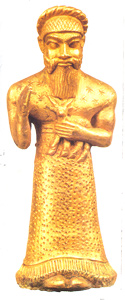 |
| En, Naram-Sin | Victorious! Stele of En, Naram-Sin leading Kussi (Black) troops against the Lulubi (Black) troops) | Gudea, man of peace | An Elamite/Susian Leader (notice the similarity to the Sumerian Dingir [god] EnKi [above, and below left]) |
Sumer's greatness and grandeur was both alluring and a magnate to the Aryan-Semites and the Aryan-Europeans who began to invade its territory and society until they finally conquered, dominated and destroyed it greatness. At the hands of the nomadic-barbarians the Sumerians (Africans) experienced invasions of their homeland, pillage of their resources, genocide, rape, slavery, exile, colonization, cultural theft, barbarism, and racism (in its beginning stages). From as early as 2,200 BCE Sumer, including its African neighbor Susa/Elam, endured the invasions of one increasingly brutal nomadic-barbaric 'White' people after another. Under the invasions of the Martu, also called the Assyrians, the strength of the African population known as Sumerian in Mesopotamia was defeated resulting in complete and utter domination at the hand of barbaric warring populations set on plunder and exploitation.
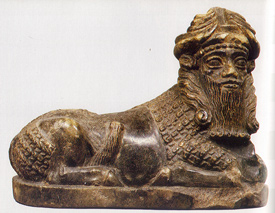 |
 |
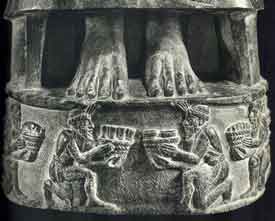 |
| Dingir, Enki (God-Ruler of Earth) as a 'Royal Bull' | Sumerian Royal Couple - Wife and Husband | Offerings brought to Ur-Ningirsu (base of Ur-Ningirsu stature) |
In addition to other benefactors, the Jewish and Arab culture and society - its religion, philosophy and government - also developed upon the plunder, domination and exploitation of the Sumerian; and including some Southern-European societies - among them Greece.
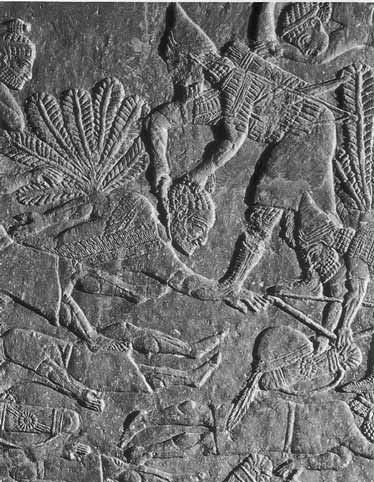 |
 |
| The Elamite/Susian army defeated by the Assyrians, who brutally decapitated the Elamite leader. Similar barbarity was perpetrated upon the Sumerians | After developing civilization in Sumer / Mesopotamia, three-thousand years later, Africans are now sold by enslaving barbaric-Arab tribes [1237 AD Yemen, Baghdad, Iraq (formerly Sumer)] |
About the images:
Sumerians represented their Dingir (gods) with crowns of 'bull horns', major Dingir wore numerous horns [collectively they were called the Annunaki], while lesser Dinger wore fewer horns [collectively they were called the Iggigi]. Leaders, called En were considered 'Lesser Dinger' incarnate, they are almost always depicted wearing the 'Royal Beard' and sometimes with a bull horned crown. Priest (male) are, almost always depicted as clean-shaven and without head hair.
Interestingly, in spite of the ongoing invasions and colonization the Sumerians', and the Elamites/Susians, continued to depict their Dingir (gods) in their image.
In spite of the above images and documentation to the contrary, it is interesting, and no less disturbing, that the school of 'White' researchers and writers of Sumer / Mesopotamian history have organized as a race-biased (racist) group to perpetuate a lie-myth-deceit and other falsehoods to deny the race (i.e. Black / African) of the Sumerian, and of the origin of Sumerian civilization. Somehow they do manage to find Africans among the population when they are conquered or enslaved.
References:
Anu, Heru-Ka, Kemet Way: The Triumph of African Civilization Over Aryan Barbarism, (publication pending)
Black, Jeremy, et.al., (1992), Gods, Demons and Symbols in Ancient Mesopotamia, University of Texas Press
Black, Jeremy, et.al. , (2004), The Literature of Ancient Sumer, Oxford University Press
Brunson, James E. ,(1990), Image of the Black In West Asian Art (5000 - 650 B.C.) - Kara Publishing
Budge, E.A.Wallis, (1895/1967), The Egyptian Book of the Dead, Dover Publications
Diop, Cheikh Anta, (1967/1974), The African Origin of Civilization; Myth or Reality, Lawrence Hill & Company
Parrot, Andre, (1961), Sumer The Dawn of Art, Golden Press (Ny)
Prichard, James B., (1969 [vol. 1], 1975 [vol. 2]), The Ancient Near East - An Anthology of Texts and Pictures, Princeton University Press
Sertima, Ivan Van, (1985), African Presence In Early Asia ("Africans In Early Asian Civilizations: A Historical Overview" - Runoko Rashidi, pp. 15-51), Journal of African Civilizations / Transaction Books
Sertima, Ivan Van, (1989/1991, Egypt Revisited ("The Lost Pharaohs of Nubia" - Bruce Williams", pp. 90-104), Journal of African Civilizations / Transaction Books
Images:
Lewis, Bernard, (1990), Race and Slavery In the Middle East, Oxford University Press
Parrot, Andre, (1961), Sumer The Dawn of Art, Golden Press (Ny)
Saggs, H.W.F., (1995), Babylonians, University of Oklahoma Press